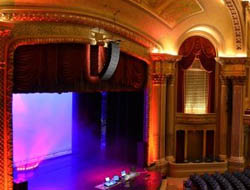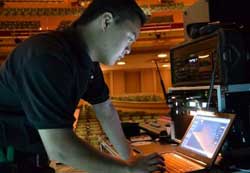
A collaborative effort
The Hawaii Theatre sound system upgrade had its genesis seven years ago when the venue was the site of Electro-Voice’s first ever EV Road Show in Hawaii. The task of locating a venue for such an event was put on the shoulders of Buck Tallman of Quantum Sales & Technology, the regional Electro-Voice representative for Hawaii. “Although we had several options available for our show, the Hawaii Theatre had that WOW factor that we needed to help highlight the products offered by Electro-Voice.”
“Great location plus great sound equals great show! That’s exactly what this was – a great showing products that no one had ever done before in this territory, and all at a location as great as the Hawaii Theatre,” says Tallman.
Hosting the Road Show also gave the theater’s Jude Lampitelli, who was stage manager at the time and has since become production manager, to hear what newer Electro-voice systems could do. As time passed, Lampitelli kept in touch with Tallman and Quantum helped provided the theater with sales and service for EV and Telex intercom systems. “We always try to involve local support for the sales and service of our product offerings,” says Tallman. “Local communities benefit when sales or service is kept within that territory.”
It was four years ago that Lampitelli informed Tallman that the venue was considering a sound system upgrade and requested a sample design be drawn up for budgetary purposes. A year later, center manager Burton White began seeking grant money for the project, and a year after that a grant was approved for about half of the needed amount. The center’s members launched a fundraising campaign, and after another year they had raised enough to match the grant.
With funding assured, the design and installation process began in earnest, eventually involving Custom Audio of Kaneohe, Hawaii. Custom, an installation, rentals, and event sound company, was Quantum’s key local partner on the job.
“Quantum did a lot of groundwork to specify the current system as installed, from acoustical predictions to keeping within the theater’s historical and aesthetic parameters,” says Custom’s Jeff Kang, the systems engineer who oversaw the installation. “They designed an excellent system that really fits the space.” Going along with the philosophy of always involving local support, Custom will provide ongoing local support for the system.
“The biggest design challenge came from the fact that it is a historic building,” says Tallman. “Most of the room is covered in plaster handcrafted by local artisans, and it looks spectacular. Because of the historical value of the venue there could be no altering to the existing hang point. The system had to go up in the exact same spot where the old system was hung, which was a single, center rigging point about five feet in front of the proscenium, over the front part of the stage.”
The old center cluster was a horizontal array of six boxes, three wide and two tall. It was supplemented with a pair of single-18 subwoofers, and a set of barely-functional in-ceiling speakers for under-balcony fill. “Sticking with a single hang in the same spot as the old cluster limited our choices,” Tallman says. “We had a few options on what we could put in that would perform well from that predetermined point in the room. We also had to take into account the size of the proscenium, and the aesthetics,” Tallman continues. “When you looked up, were you going to see a big behemoth, a monolithic array, or was it going to blend in seamlessly to the architecture?”
Another consideration was that the center already had a clear vision of the type of system they wanted. “The customer definitely wanted to see a line array in there,” Tallman says. “Given that we had a single hang point with weight limitations, our options were narrowed down to a few possible speakers for the centerpiece of this install.”

Lastly, the system had to be versatile, able to handle a broad cross-section of performance types. So they had a wide variety of needs for the system. It couldn’t be just a point source, theater-oriented type system that was for voice and prerecorded music. It had to be able to achieve the SPLs that a rock concert would normally want in that room, and also have enough bottom end too,” says Tallman.
